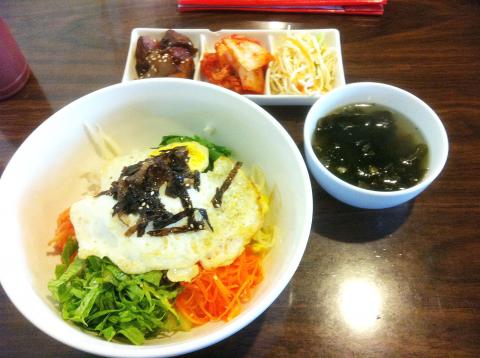After visiting Alilang (阿里郎), a plate lunch anywhere else will feel like a disappointment. The Korean restaurant, located in New Taipei City’s Yonghe District, serves a tasty bibimbap (拌飯), or rice with mixed vegetables and meat, at a nice price — NT$130 with either beef or pork.
Alilang’s bibimbap doesn’t look particularly special, but its mojo derives from the freshness of the ingredients. After countless bowls at department store food courts and budget Korean eateries in the Shida (師大) neighborhood, I gained a sudden appreciation for what finely shredded carrots, crunchy bean sprouts, spicy kimchi and a fried egg could do when mixed in harmony. My bowl practically sang, “Where have you been all this time?”
What I liked even better was the restaurant’s dolsot bibimbap (有機芽石鍋拌飯, NT$170). This has the same ingredients as the regular bibimbap, except that the egg is raw instead of fried, and everything sits in a sizzling hot black stone bowl, which you should absolutely not touch when it arrives at the table. Do, however, use your chopsticks and spoon to mix everything right away. At the bottom of the bowl is a layer of sesame oil, which adds a nice crispness to the rice. (Don’t take the Chinese name for this item literally: youjiya (有機芽) implies that the bean sprouts are organic when they’re really not. The name is just meant to make the dish sound attractive, according to the waitstaff).

Photo: David Chen, Taipei Times
For those who judge a restaurant by its soup, Alilang would certainly pass muster. The seaweed soup that accompanies all of the rice plate meals, again, doesn’t look special, but the hearty broth is delicious, and made me realize that we’ve all been cheated by the watery concoctions served at most lunch box (便當) joints. Here, I actually wanted to have seconds of seaweed soup.
The same holds for Alilang’s cold appetizers, or panchan. Everything we had, from the pickled seaweed to the mildly spicy kimchi, tasted homemade. I particularly enjoyed the cubed potato, which is stewed with onions in a sweet soy sauce. The panchan is included in the price of the meal and is offered in an unlimited supply.
Other lunch selections include a kimchi hot pot bowl with rice (泡菜鍋, NT$150), which is not as spicy as it looks (though the kitchen can adjust the dish to your preferred level of spiciness). Hot pot lunch sets, which include beef or seafood, are NT$150. And you can’t go wrong with the restaurant’s specialty, barbeque beef or pork with rice (招牌烤肉飯, NT$150).
Alilang offers an extensive menu suited for dinner or large parties, which includes Korean favorites such as seafood pajeon (海鮮煎餅, NT$200), a flour pancake made with scallion, and copper-plate barbeque and hot pot with beef (銅盤牛肉, NT$220). Family-style main course dishes run between NT$300 and NT$500, and include another specialty, Shandong-style barbeque chicken (山東燒雞, NT$300), as well as ginseng chicken (人參雞, NT$350) and budae jjigae (部隊鍋, NT$400), or literally “army base stew.”
Alilang is situated in a renovated Japanese-era house, but the plain-Jane decor (cheap wallpaper and plywood tables) is not the restaurant’s strong suit. Still, the place is spacious and comfortable enough to enjoy an extended hot pot meal, and the food is worth a try if you’re in the neighborhood. The restaurant is a five-minute walk from Dingxi MRT Station (頂溪捷運站), Exit 2.

On April 26, The Lancet published a letter from two doctors at Taichung-based China Medical University Hospital (CMUH) warning that “Taiwan’s Health Care System is on the Brink of Collapse.” The authors said that “Years of policy inaction and mismanagement of resources have led to the National Health Insurance system operating under unsustainable conditions.” The pushback was immediate. Errors in the paper were quickly identified and publicized, to discredit the authors (the hospital apologized). CNA reported that CMUH said the letter described Taiwan in 2021 as having 62 nurses per 10,000 people, when the correct number was 78 nurses per 10,000

As we live longer, our risk of cognitive impairment is increasing. How can we delay the onset of symptoms? Do we have to give up every indulgence or can small changes make a difference? We asked neurologists for tips on how to keep our brains healthy for life. TAKE CARE OF YOUR HEALTH “All of the sensible things that apply to bodily health apply to brain health,” says Suzanne O’Sullivan, a consultant in neurology at the National Hospital for Neurology and Neurosurgery in London, and the author of The Age of Diagnosis. “When you’re 20, you can get away with absolute

May 5 to May 11 What started out as friction between Taiwanese students at Taichung First High School and a Japanese head cook escalated dramatically over the first two weeks of May 1927. It began on April 30 when the cook’s wife knew that lotus starch used in that night’s dinner had rat feces in it, but failed to inform staff until the meal was already prepared. The students believed that her silence was intentional, and filed a complaint. The school’s Japanese administrators sided with the cook’s family, dismissing the students as troublemakers and clamping down on their freedoms — with

As Donald Trump’s executive order in March led to the shuttering of Voice of America (VOA) — the global broadcaster whose roots date back to the fight against Nazi propaganda — he quickly attracted support from figures not used to aligning themselves with any US administration. Trump had ordered the US Agency for Global Media, the federal agency that funds VOA and other groups promoting independent journalism overseas, to be “eliminated to the maximum extent consistent with applicable law.” The decision suddenly halted programming in 49 languages to more than 425 million people. In Moscow, Margarita Simonyan, the hardline editor-in-chief of the